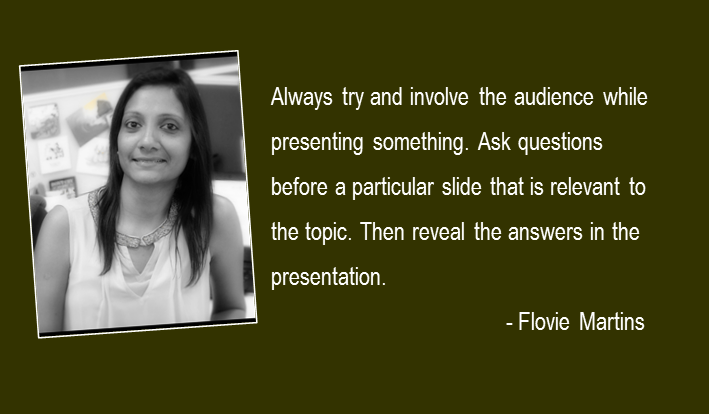Making presentations can be a killer task, not to mention boring and in some cases frightening. Many times, you don’t have much time to prepare them either. Acing this task may seem like a dream – but I believe it can be achieved. We as communicators have an edge over our sales counterparts, to make them interesting. We are in the business of creative thinking. Our presentations can definitely be interesting while being informative.
Let’s analyse how. Always have a template in mind that is your ‘Go to’ format and can be tailored as needed. When I am asked for a deck, It represents my work through my eyes. This is the template I always have in mind and when getting down to shaping it – I apply ‘me’, ie my touch of creativity to it. There is no right and wrong, as long as you can make sense of it while presenting it.
- Get the purpose right
Always be clear on the purpose of the deck. Is it for a review – which in our case, most times it is. But it can also be presenting a case for something, a new project undertaking, an educative workshop on a particular topic, a case study of how a project faired etc. Once the end objective is clear, the road to achieving it can be paved. Eg you are working on a deck for a workshop. This means the content needs to be educative in nature, on the said topic. So it may involve research work.
- ‘KISS’ it –Keep It Simple, Stupid
Simplicity is the key to making a presentation. Making it complex only leads to more questions and question mark faces. Keep the language simple unless otherwise required to use a word as in eg legal terms / industry terms. Try applying the basic concepts of ‘B1 language’ writing. Amongst its other concepts, B1 language writing teaches us to use simple language. Avoid writing long sentences, where one gets lost at the end of reading it. Use a sub heading for a paragraph, if needed. This helps in keeping contextual content together.
- Go with the flow
Start with putting dummy slides together. If you have a thought and not the flow in mind, it doesn’t matter. Prepare that slide with the intended heading. Then keep changing and aligning to make sense to the flow as you move ahead. Eventually when you have put down everything, you will find a flow to it. But it is important to be clear on what you want to convey. Always have 3 parts to making the deck. Begin with an introduction or a background to the topic. Then move to the main content and end with an insight or a way forward plan. Always index the flow of the presentation at the beginning itself. This not only helps sectionise the content, but also gives a perspective to the whole presentation. Putting the main titles of the section again at intervals in the presentation, when starting a new section is also a good practice.
- Instead of text heavy slides, make it visually appealing
This is one main element, that is just taken for granted. A slide that is heavy with words, graphs, tables will make people lose interest in it. On the other hand, converting words to pictures that are relatable to the content, has an impact on the understanding of it. Use a one word or sentence description and have a picture to depict the content. Then verbally explain the content that you would have otherwise put on the slide.
- Keep it uniform
Many times, we see long presentations with a crazy number of slides. While it’s not the length of the deck that is a problem, it could be lacking a uniform look, feel and flow. This could make the presentation complex to understand. And this in turn could jeopardise all the hard work put into making the presentation. While title slides indicate a section break, there may also be a need to put subtitle slides. These again should be uniform in look and design. It is also important to make sure that you are using the same font, design and colour scheme throughout the deck. This is especially true when not using a readymade PowerPoint template.
- Make it a two-way communication
Always try and involve the audience while presenting something. Ask questions before a particular slide that is relevant to the topic. Then reveal the answers in the presentation. Also try to make the conversation fun wherever possible. The idea is to keep the audience involved and engaged. This helps in keeping them attentive to the conversation. If wanting to give an anecdote or narrate a funny story, do take into account the situation and mood in the room. During a serious review and especially if the results aren’t as expected, you may want to stick to the presentation flow.
- Play with it
Design your own slides. Create your own title and breakaway slide designs with what excites you. Be creative while doing away with traditional formats. As mentioned above, there is not right and wrong. If at all when people experience something different than the usual, it catches their attention. They will most definitely appreciate the effort put into making the presentation.
Always run the presentation by yourself once – twice. If you think you will miss out on details while presenting, it’s ok to make notes and have the sheet in hand when presenting. The most impact this kind of a presentation has on its audience is that you come across as someone who knows what he/she is doing in their role. People leave the room having understood what was presented. This attains the original purpose of working on the deck.



Be the first to comment on "Presentation Nightmares"